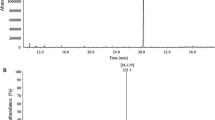Abstract
Trimetoquinol (TMQ) (1-(3’,4’,5’-trimethoxybenzyl)-6,7-dihydroxy-1,2,3,4-tetrahydroisoquinoline, m.w. 345) is the prototype tetrahydroisoquinoline pharmaceutical. TMQ is marketed as a bronchodilator in human medicine; in horse racing, TMQ is listed as an Association of Racing Commissioners International (ARCI) class 3 foreign substance. As such, TMQ is considered to have the potential to affect racing performance in horses, and a validated qualitative confirmatory method is required to regulate its use in racing. We selected 8 μg kg−1 of TMQ IV as a safe and effective dose for studies on its metabolism and analytical detection in horses. We developed a solid phase extraction method for recovery of TMQ and its metabolites from equine urine, identified suitable high performance liquid chromatographic conditions for these substances and our internal standard, papaverine, and developed a highly sensitive ESI(+)-LC-MS-MS method (estimated LOD, 100 pg mL−1) for TMQ and its major metabolites in equine urine. Multiple Reaction Monitoring (MRM) analysis of unhydrolyzed post-administration urine showed small amounts of unchanged TMQ, along with glucuronide, methylated, and sulfated metabolites, with glucuronide metabolites predominating. Following glucuronidase hydrolysis, recovered parent TMQ peaked at relatively high concentrations (>300 ng mL−1) within 1 h of administration and thereafter declined. The methylated metabolites of TMQ peaked later and at comparable total concentrations, and thereafter declined more slowly. These data suggest that glucuronide hydrolysis of post-administration urine samples will allow recovery of readily identifiable quantities of parent TMQ. These findings, combined with the highly sensitive LC-MS-MS detection of parent TMQ described herein suggest that glucuronide hydrolysis of post-administration urine, followed by LC-MS-MS or other analysis, will allow effective regulatory control of this agent in racing horses.
Similar content being viewed by others
References
Iwasawa Y, Kiyomoto A (1967) Jpn J Pharmacol 17:143–152
Shin Y, Romstedt KJ, Miller DD, Feller DR (1993) J Pharmacol Exp Ther 267(3):1017–1023
Feller DR, Piascik MT, Miller DD (1978) Activation of adrenoceptors and adenylate cyclase in adipocytes by catecholamines and tetrahydroisoquinolines. In: Recent Advances in the Pharmacology of Adrenoceptors, Szabadi, E; Bradshaw, CM; Bevan, P (eds) Elsevier, New York p. 111
Holzmann S, Meinertz T, Nawrath H, Scholz H (1977) Effect of papaverine on cyclic AMP, calcium uptake and force of contraction in isolated guinea-pig auricles. Res Commun Chem Pathol Pharmacol 16(3):443–450
Lands AM, Arnold A, McAuliff JP, Luduena FP, Brown TG (1967) Nature 214(88):597–598
Emorine LJ, Marullo S, Brien-Sutren MM, Patey G, Tate K, Delavier-Klutchko C, Strosberg AD (1989) Science 245(4922): 1118–1121
Arch JR, Ainsworth AT, Cawthorne MA, Piercy V, Sennitt MV, Thody VE, Wilson C, Wilson S (1984) Nature 309(5964):163–165
Konkar AA, Fraundorfer PF, Fertel RH, Burkman AM, Miller DD, Feller DR (1996) Eur J Pharmacol 305:63–71
Konkar AA, Vansal SS, Shams G, Fraundorfer PF, Zheng WP, Nikulin VI, De Los Angeles J, Fertel RH, Miller DD, Feller DR. (1999) J Pharmacol Exp Ther 291(2):875–883
Mehta RC, Salazar-Bookaman MM, Fertel RH, De Los Angeles J, Nikulin VI, Fraundorfer PF, Miller DD, Feller DR (2000) Biochem Pharmacol 59:517–529
Konkar AA, Nikulin VI, De Los Angeles J, Hong SS, Fertel RH, Miller DD, Feller DR (2001) Pharmacology 62(1):45–55
Hoffman BB (2001) Adrenoceptor-activating and other sympathomimetic drugs. In: Bertram G. Katzung (ed) Basic and Clinical Pharmacology. San Francisco, California, pp. 120–137
Dirikolu L, Lehner AF, Hughes C, Karpiesiuk W, Camargo FC, Harkins JD, Woods WE, Bosken JM, Boyles J, Troppmann A, Fisher M, Tobin T (2003) Vet Ther 4(4):350–363
Combie J, Blake JW, Nugent TE, Tobin T (1982) Clin Chem 28:83–86
Ikezawa K, Takenaga H, Sato M, Nakajima H, Kiyomoto A (1977) Jpn J Pharmacol 27(4):537–544
Yabuuchi Y, Yamashita S, Tei S (1977) J Pharmacol Exp Ther 202(2):326–336
Nakanishi H, Nakahata N, Ito G, Yoshida H (1980) Res Commun Chem Pathol Pharmacol 28(1):185–188
Mukhopadhyay A, Sober DJ, Chang J, Slenn RT, Amin HM, Miller DD, Feller DR (1982) Eur J Pharmacol 77(4):209–219
Babich M, Atkinson J, Piascik M (1985) J Mol Cell Cardiol 17(6):565–574
Yamamura Y, Kishimoto S (1968) Annals of Allergy 26(9):504–507
Mirbahar KB and Eyre P (1981) J Vet Pharmacol Therap 4(4):317–319
Meshi T, Otsuka M, Sata M (1970) Biochem Pharmacol 19:2937–2948
Acknowledgments.
This work was made possible by research support from the National, Alabama, Arkansas, Kentucky, Pennsylvania, Ohio, Michigan, Charles Town WV, Florida, Nebraska, Ontario, and Canada Horsemen’s Benevolent and Protective Associations.
Author information
Authors and Affiliations
Corresponding author
Additional information
Published as # 351 from the Equine Pharmacology, Therapeutics and Toxicology Program at the Maxwell H. Gluck Equine Research Center and Department of Veterinary Science, University of Kentucky. Published as Kentucky Agricultural Experiment Station Article # 04-14-048 with the approval of the Dean and Director, College of Agriculture and the Kentucky Agricultural Experimental Station.
Revised: 8 June and 12 July 2004
Rights and permissions
About this article
Cite this article
Camargo, F., Lehner, A., Harkins, J. et al. Chromatographic Detection of Trimetoquinol (Inolin®) and its Major Urinary Metabolites in the Horse: A Preliminary Report. Chromatographia 60, 371–378 (2004). https://doi.org/10.1365/s10337-004-0405-7
Received:
Accepted:
Published:
Issue Date:
DOI: https://doi.org/10.1365/s10337-004-0405-7




